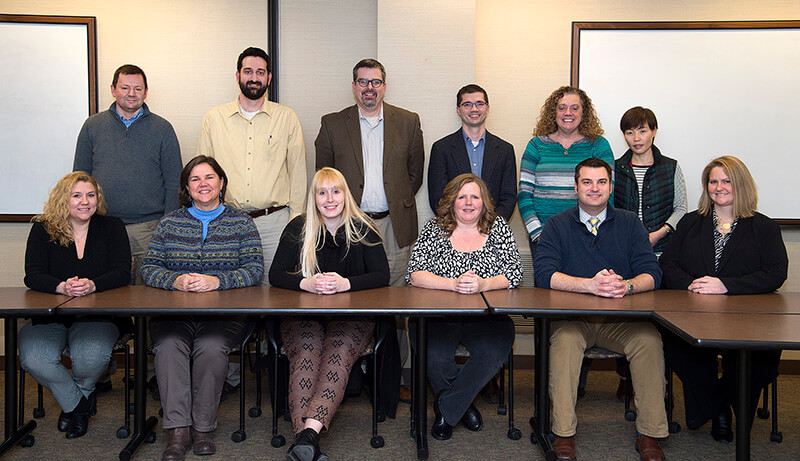March 21, 2017
Transform Purdue: A look into the Enterprise Asset Management project transformation
 Enterprise Asset Management team: (front row, from left) Tonya Yoder, Diane Windler, Morgan Grosso, Jennifer Clingenpeel, Nathan Manges, Pam Williams, (back row, from left) Aaron Veach, Russ Wetli, John Higgins, Ben Dispennett, Melissa Maze, Emma Zhang. (Purdue University photo/Mark Simons)
Download image
Enterprise Asset Management team: (front row, from left) Tonya Yoder, Diane Windler, Morgan Grosso, Jennifer Clingenpeel, Nathan Manges, Pam Williams, (back row, from left) Aaron Veach, Russ Wetli, John Higgins, Ben Dispennett, Melissa Maze, Emma Zhang. (Purdue University photo/Mark Simons)
Download image
The plan to transform Purdue continues through the Business Process Reengineering team. The multilayered approach to the transformation, geared to do business better across the University, is spearheaded by the ongoing projects -- Enterprise Asset Management, General Ledger (Finance), Human Capital Management, Reporting and Technology.
For employees to better understand each project within the transformation, Purdue Today will explore each one.
Here, John Higgins, EAM team lead, answers questions about the group:
Who is on the EAM team?
The EAM team is composed of Jennifer Clingenpeel, Ben Dispennett, Morgan Grosso, Melissa Maze, Nathan Manges, Aaron Veach, Russ Wetli, Pam Williams, Diane Windler, Tonya Yoder and Emma Zhang.
We work closely with the other project teams, and our stakeholders.
What are the overall goals/mission of your team?
Complex processes coupled with time-consuming data collection activities have affected Purdue's ability to produce timely, transparent and efficient financial and managerial reporting. To address these issues, members of the enterprise asset management team are working to:
* Streamline maintenance processes with the use of mobile technology.
* Redesign underlying business processes and policies based on a “standard” application of the software including mobility enhancements.
* Eliminate duplication in business processes and IT software systems.
* Reengineer business processes and the underlying system infrastructure to provide meaningful information to facilitate strategic planning for capital assets.
What has the team been working on so far during the design phase?
We have two work streams -- maintenance and capital projects -- in order to achieve the above objectives. The maintenance project has been working hard to define streamlined processes with regard to the way that maintenance work orders are created, assigned and completed. The team is focused on making this process intuitive, efficient and visible to those working with orders across campus.
The capital projects team is busy defining processes to identify capital projects as they are conceived across campus, streamlining the intake and prioritization processes and ensuring that all of the data collected, such as schedules, contract information and finances, are maintained in a manner that will allow for reporting on the portfolio.
What challenges have you encountered?
Our teams are working hard to redesign complex processes and learning new system functionality while doing so. The effort to think creatively, design best practices and remain true to baseline system configuration in new systems is an art and a challenge. I have a great deal of respect for individuals who have been involved and are working to improve on the way we do business day to day.
How many workshops have you held as part of the design phase? Which units been involved, and what topics have been discussed?
We have completed just over 50 workshops across the two projects. The majority of these workshops include Physical Facilities staff (Operations and Maintenance, Energy and Utilities, Capital Management, Asset Management, and other areas). Our workshops also have included staff from Student Life, Transportation Service, Financial Affairs, Comptroller and others across the University. Topics are wide-ranging but include items like job assignment, work identification and planning, capital ideation and capital portfolio reporting as examples.
Design-phase workshop documentation can be found on our EAM webpage.
What is coming up next for your group in the next few months?
We will be moving from the design to the build/realization phase. While we will continue to work and rework process workflows, the focus will move to building and testing the processes that we have redesigned in order to streamline, simply, organize and automate business throughout the University.
What do you want faculty and staff to know about your team and efforts?
In the end, we will be successful if:
* Customers have visibility of the status of their work order.
* Transparency into capital projects is improved for all stakeholders.
* There is the ability to view the capital portfolio across multiple dimensions (project type, client ownership, funding, campus, phase, etc.).
* The costs of maintaining assets are known and trusted.
* We spend less time reconciling data and put more focus on planning the right projects at the right time.
More on the transformation
* Review the first article in this series, Efforts to Transform Purdue business: A BPR Overview.
* Explore our website for an overview of the transformation projects.
* Provide feedback by submitting a pain point, completing a survey or sending an email.
* View previous presentations and publications for more information.

